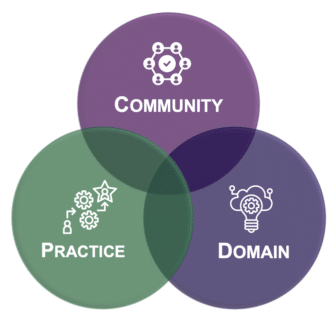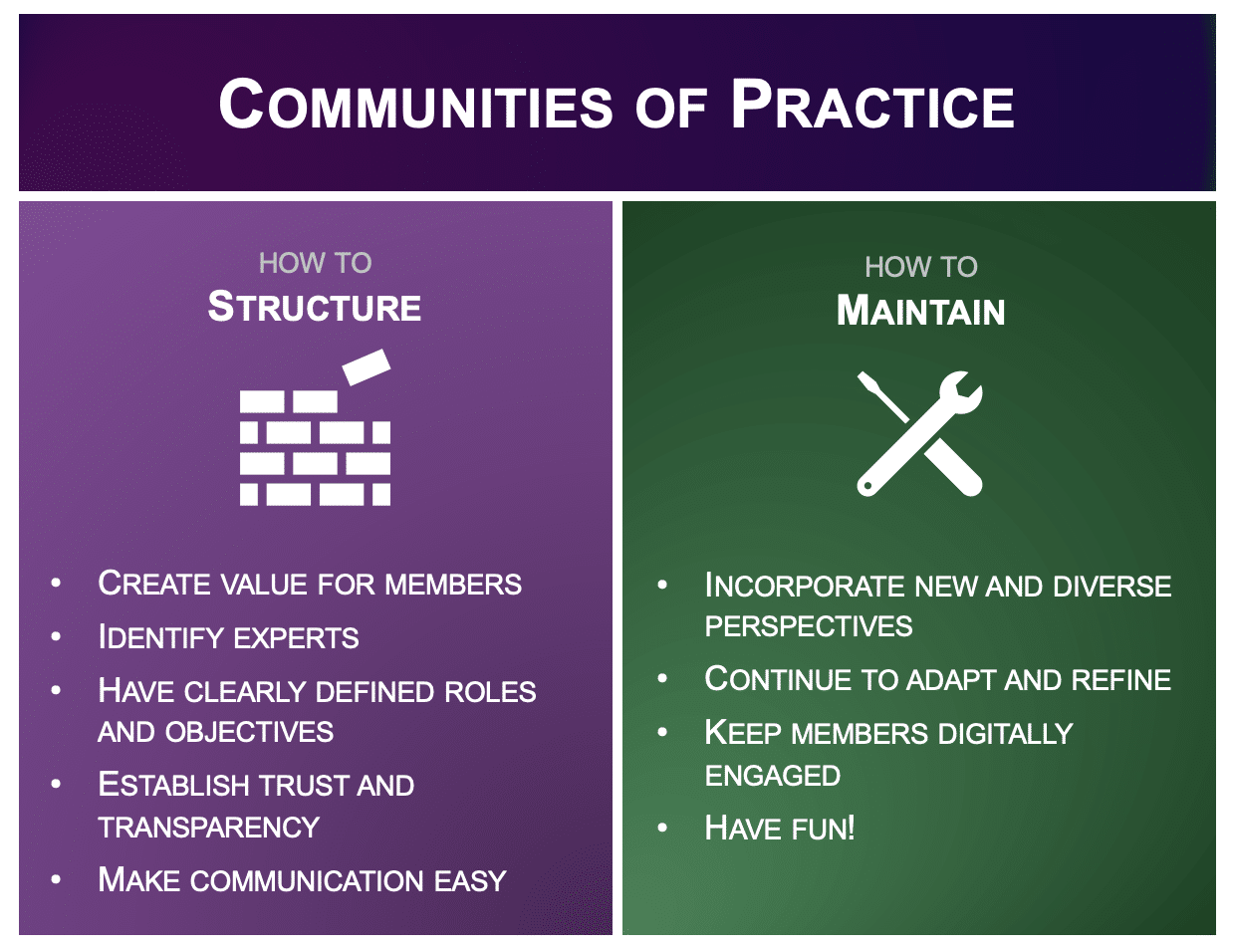What Are Communities of Practice?
You may have picked up a few new hobbies or pursuits during the COVID-19 pandemic, but have you done anything to nurture your existing professional interests and areas of expertise? A community of practice (CoP) provides an excellent opportunity to cultivate these interests while engaging with coworkers whom you probably haven’t had a chance to interact with very much over the last several months. This method of knowledge building is even more valuable while we’re isolated in our homes, craving social interaction. If you’re not familiar with the term, a community of practice is an organized group of people with a common professional interest who meet regularly to learn from each other through sharing ideas, experiences, and best practices. Unlike a “community of learning” which is focused on helping people learn new concepts, communities of practice help people develop proficiencies in fields in which they are already familiar.
Communities of practice are a great way to build morale and generate excitement around shared competencies, but it can be difficult to facilitate remote CoPs in a world where many of us are on our computers all day and experiencing very real video call fatigue. In this blog post, I will demonstrate the importance of CoPs in the context of KM and provide some tips on how you can cultivate and maintain communities of practice within your organization to motivate your colleagues to take a proactive approach to professional development and innovation in a time when employee engagement, skill building, and social interaction can be challenging.
Why Communities of Practice are Important for Knowledge Management
Communities of practice go hand-in-hand with good knowledge management. Given that internal knowledge is a company’s competitive advantage, CoPs are effective mechanisms for capturing and sharing information across the organization. They provide employees with opportunities to collaborate, capture, and share knowledge that can improve performance and efficiency at an organizational level while also reducing duplication of work. As a result, employees will feel empowered to be more innovative, promote best practices, and find greater satisfaction in their jobs. The more CoPs are used, the more they aid in tacit knowledge capture. As employees participate in communities of practice through various communication technologies, they are essentially transferring their tacit knowledge into a digital form where it can be leveraged by current and future employees. This ability to capture and share the experience and expertise of an organization’s individuals is a key element of KM maturity.
How to Create Sustainable Communities of Practice
If you are contemplating starting a new CoP within your organization, it’s important to keep the following in mind to ensure that you are creating something that will be beneficial to your community. Here are some suggestions for structuring a new CoP to set it up for success.
- Create value: People join communities of practice because they are passionate about a particular technical area or business domain. They are typically already fairly knowledgeable in this subject area so it is important to provide in-depth information or unique perspectives and methodology that will help individuals do their jobs better and distinguish themselves in the field.
- Identify and incorporate your organization’s most recognized experts: Include individuals within your organization known for their expertise in the early stages of CoP development and pre-populate great knowledge and discussions before launch. We often refer to this as seeding content within CoPs. This will evoke interest and drive adoption by demonstrating to participants how CoPs might benefit their professional development.
- Define roles and objectives: If you want the CoP to be a sustainable entity, create a guiding strategy and get clear on how the group will be managed. Consider what roles you need and who will serve in them, and what principles will guide decision-making around content that is shared. Also, set up a schedule with regular meetings and create a calendar of events for participants. Set clear expectations for participation and discuss what success as a community looks like for the group.
- Establish trust and transparency: Don’t make it all about business! Provide participants with the opportunity to converse casually. If the group consists of mostly new faces, find ways to make connections amongst members on a more personal level. Allow for unstructured time on the agenda and create an environment where people feel comfortable asking questions, being vulnerable, and taking risks. Consider keeping the CoP closed from management to foster an environment where employees can openly speak about problems and knowledge gaps.
- Make it easy for people to communicate with each other: Create a centralized, digital location to access and share information (if one doesn’t already exist), while making it easy for community members to engage. It is especially important to facilitate connections across boundaries, given that people are geographically dispersed due to the pandemic. As EK’s CEO, Zach Wahl, has previously mentioned, it is important to leverage frequently used communication channels. As it becomes easier to share information, levels of participation and engagement will increase. Ensure that technology supports the community but that it does not define the community. In other words, the digital platform is one part but there should also be face-to-face conversations (when feasible), virtual meetings, and other synchronous activities and gatherings. Stick to whatever platform your company uses for meetings, but find other ways to create engaging content through breakout rooms or complementary tools.
How to Maintain Communities of Practice
Once you have an established structure in place that provides a safe space where people feel comfortable sharing experiences and ideas, you must continue to provide value to keep members engaged. By inviting unique perspectives to contribute to the discussion and soliciting feedback from participants, members will have actionable ways to contribute, become invested in the continued success of the CoP, and remain active in the community. Below are a few examples of ways that you can keep your members engaged and provide enduring professional enrichment.
- Incorporate new, diverse perspectives: Deliver compelling content that will continue to draw people back. Because CoPs are comprised of experts and experienced professionals, if you’re not providing new and thought-provoking ideas, your members will become bored and eventually drop off. This can be done by discussing controversial topics, encouraging vulnerability, and sharing stories of failure from which to reflect and grow.

- Continue to adapt and refine: If you’re noticing a decline in participation, speak with members of the group and find out ways to improve or pivot in order to bring people back and draw in new members. Aim to cover topics that meet at least 80% of your members’ needs to ensure that content is relevant to your CoP. Even if your audience participation is great, try to figure out what is drawing people in and continue to replicate and refine those aspects.
- Make it fun!: Make meetings and events interactive and dynamic. One of the best virtual meetings I’ve attended was a mix of presentations and a few “breaks” where we had the chance to chat for 10 minutes with other attendees one-on-one. It split up what could have been a rather boring presentation and allowed participants to network and socialize.
- Stay engaged in-between meetings. Use social media and online forums to your advantage. Have a closed channel dedicated to sharing articles and educational resources amongst the CoP to maintain a safe space but also share ideas with a wider audience via Twitter and LinkedIn to gain outside perspectives and grow your network.
As you consider how to structure and grow communities of practice within your organization, these tips will provide guidance to facilitate effective and sustainable knowledge transfer. CoPs can be an incredibly powerful tool to promote collaborative learning while enriching knowledge management across your organization.
Looking to incorporate communities of practice into your organization? Contact us at Enterprise Knowledge for support!
